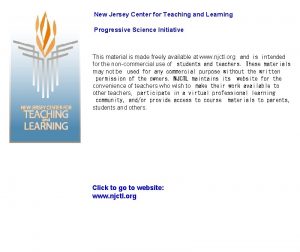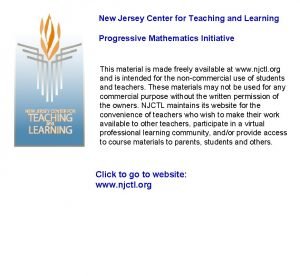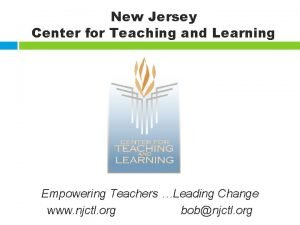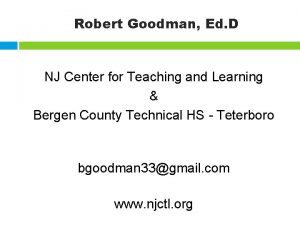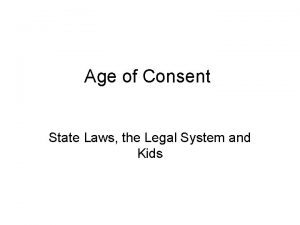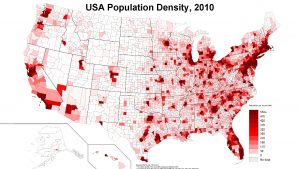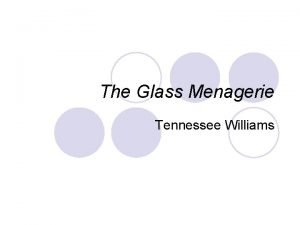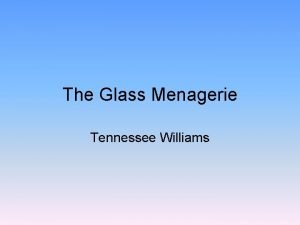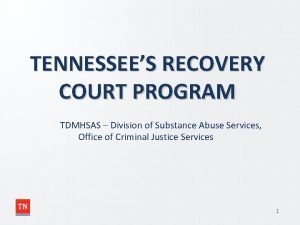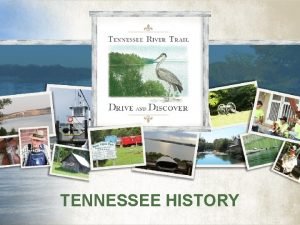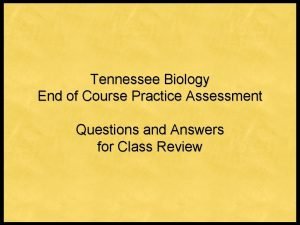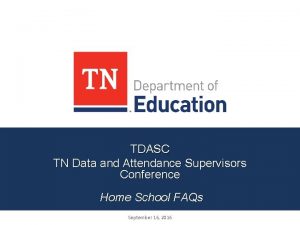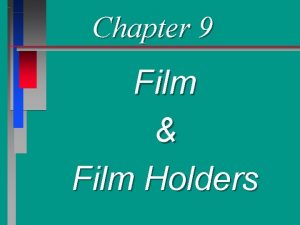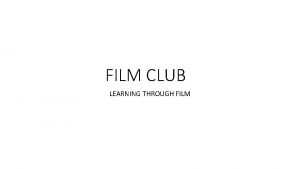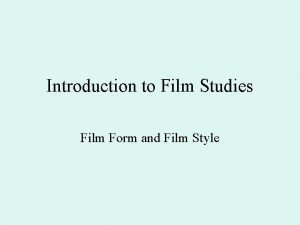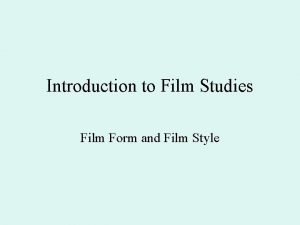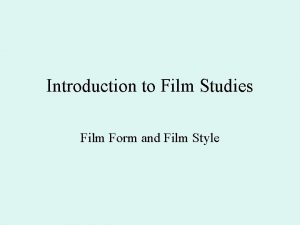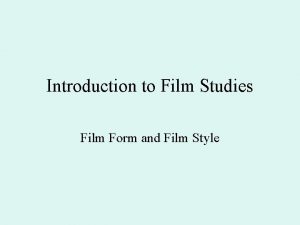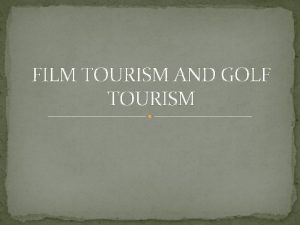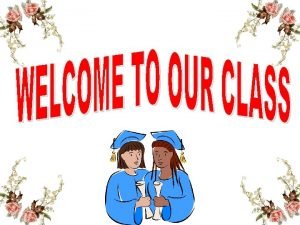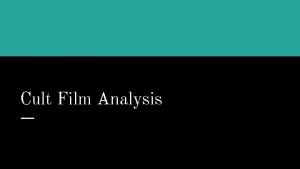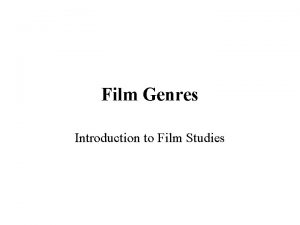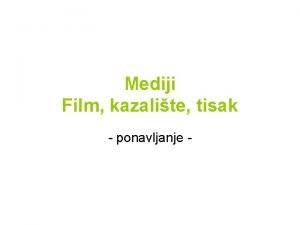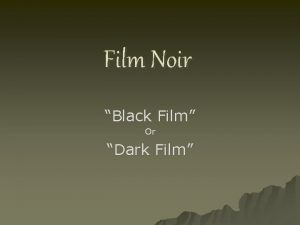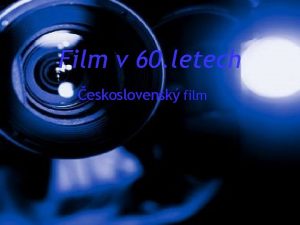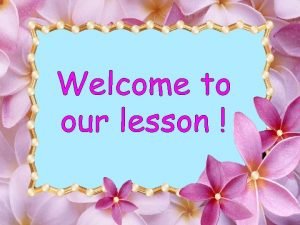Teaching With Film Tennessee Teaching and Learning Center
















- Slides: 16

Teaching With Film Tennessee Teaching and Learning Center at the University of Tennessee, Knoxville www. tenntlc. edu Dr. Taimi Olsen, Assistant Director June 7 2010

The purpose of this workshop is to understand film analysis and to plan for the use of a film in your classroom. Participants will use the tenets of visual and media literacy and practice film analysis.

Visual Literacy The term “Visual Literacy” was first coined in 1969 by John Debes, who offered the following definition of the term: “Visual Literacy refers to a group of visioncompetencies a human being can develop by seeing and at the same time having and integrating other sensory experiences. The development of these competencies is fundamental to normal human learning. When developed, they enable a visually literate person to discriminate and interpret the visible actions, objects, symbols, natural or man-made, that he encounters in his environment. Through the creative use of these competencies, he is able to communicate with others. Through the appreciative use of these competencies, he is able to comprehend and enjoy the masterworks of visual communication. ”

In his 1997 article “Thoughts on Visual Literacy, ” Philip Yenawine describes visual literacy as: "…the ability to find meaning in imagery. It involves a set of skills ranging from simple identification (naming what one sees) to complex interpretation on contextual, metaphoric and philosophical levels. Many aspects of cognition are called upon, such as personal association, questioning, speculating, analyzing, fact-finding, and categorizing. Objective understanding is the premise of much of this literacy, but subjective and affective aspects of knowing are equally important. "

What do you see?

Strategies for Analyzing Visual Images 1. Examine the image holistically what does it represent? What is your initial reaction? Does it convey a message? 2. Consider the nature of the image Is this a professional portrait or a candid press shot? Was this video taken at a prepared ceremony or a spontaneous event? Were people, images, or objects deliberately posed to make a statement? 3. Examine perspective Is the subject depicted n close-up or at a distance? Does the subject appear in control of the environment or does the background clash or dominate the frame? 4. Analyze contrasts and contexts Is the background supportive, neutral, or hostile to the subject? Does the image depict conflict or harmony? 5. Examine poses and body language of human figures How are human figures depicted? What emotion do they seem to express? 6. Look for bias Do you sense the photographers were trying to manipulate the people or events depicted, casting them in either a favorable or negative light? 7. Consider the larger context Does the image offer a fair representation of a larger event or an isolated exception? 8. Review the image for possible manipulation Could camera angles or retouching have altered what appears to be a record of actual events? 9. Consider the story the image seems to tell What is thesis of this image? What visual details or symbols help tell the story? Source: Chapter 3, page 50, Critical Reading, “The Sundance Reader” (4 th Ed, 2006) Mark Connelly, Thomson/Wadsworth http: //www. frankwbaker. com/doc_vislit. htm

Media Literacy The definition most often cited in the US is a succinct sentence hammered out by participants at the 1992 Aspen Media Literacy Leadership Institute: Media Literacy is the ability to access, analyze, evaluate and create media in a variety of forms. Definitions, however, evolve over time and a more robust definition is now needed to situate media literacy in the context of its importance for the education of students in a 21 st century media culture. The Center for Media Literacy (http: //www. medialit. org ) now uses this expanded definition: Media Literacy is a 21 st century approach to education. It provides a framework to access, analyze, evaluate and create messages in a variety of forms — from print to video to the Internet. Media literacy builds an understanding of the role of media in society as well as essential skills of inquiry and self-expression necessary for citizens of a democracy.

CML’s Five Core Concepts 1. All media messages are constructed. 2. Media messages are constructed using a creative language with its own rules. 3. Different people experience the same media message differently. 4. Media have embedded values and points of view. 5. Most media messages are organized to gain profit and/or power.

CML’s Five Key Questions 1. Who created this message? 2. What creative techniques are used to attract my attention? 3. How might different people understand this message differently? 4. What values, lifestyles and points of view are represented in, or omitted from, this message? 5. Why is this message being sent?

Consider Scenes from Que Tan Lejos Activity 1 1. Who created this message and what creative techniques are used to attract my attention? 2. What values, lifestyles and points of view are represented in, or omitted from, this message? 3. Why is this message being sent? Activity 2 1 person gets an image 1 person gets the dialogue React to your ‘piece’ and compare to the film

Individual Reflection The exquisite connections between the culture that is lived and the language that is spoken can only be realized by those who possess a knowledge of both.

Tennessee standards: Language (year 2) Standard Number 2 (Goal Two): Gain Knowledge and Understanding of Other Cultures Standard Rationale: The study of another language enables students to understand a different culture on its own terms. The exquisite connections between the culture that is lived and the language that is spoken can only be realized by those who possess a knowledge of both. American students need to develop an awareness of other people’s world views, of their unique way of life, and of the patterns of behavior which order their world, as well as to learn about contributions of other cultures to the world at large and the solutions they offer to the common problems of mankind. Learning Expectations: 2. 1 Demonstrate an understanding of the relationship between the practices and perspectives of the culture studied. 2. 2 AND between the products and perspectives of the culture studied.

Tennessee Standards: Reading The students in grades 9 -12 will learn, practice, and internalize strategies that are essential life-long learning skills for reading, writing, understanding, and interpreting content specific materials. The strategies will be applied in the content areas of English, mathematics, science, and social studies. Skills will include: q previewing and reviewing print and non-print q activating prior knowledge q processing and acquiring new vocabulary q organizing information q understanding visual representations q self-monitoring q and reflecting text

Instructional Strategies: Terms for Reading � Critical reading is reading “text in such a way as to question assumptions, explore perspectives, and critique underlying social and political values or stances. ” (IRA and NCTE, 1996, p. 71) � Implied meaning is meaning which cannot be cited from the text but which may be drawn from the reading; reading “between the lines. ” � Metacognition is the awareness and knowledge of one’s mental processes such that one can monitor, regulate, and direct them to a desired end; self-mediation; thoughts about thinking (cognition); for example, thinking about how to understand a reading selection. � Non-print text means visual media other than printed material (e. g. , photographs, movies, symbols). � Visual message refers to non-print texts (e. g. , cartoons, posters, pictures). http: //www. state. tn. us/education/ci/english/doc/ENG_3081. pdf

What’s Next Tools For Teaching Story Board Article on Movies in the Classroom (on wiki) Pre-film questions CML philosophy (on wiki)

Resources 1. 2. 3. 4. 5. “Media. Lit. Kit. ” Center for Media Literacy. http: //www. medialit. org/focus/film_home. html “Visual Thinking. ” Center for Teaching, Vanderbilt University. http: //www. vanderbilt. edu/cft/resources/teachin g_resources/activities/vizthink. htm#stories International Visual Literacy Association http: //www. ivla. org/org_what_vis_lit. htm “Film Vocabulary Flashcards. ” Quizlet. 2010. http: //quizlet. com/168298/film-vocabulary-flashcards/ Potter, James. Theory of Media Literacy: a Cognitive Approach. Thousand Oaks, CA: Sage, 2004.
 New jersey center for teaching and learning
New jersey center for teaching and learning New jersey center for teaching and learning
New jersey center for teaching and learning New jersey center for teaching and learning
New jersey center for teaching and learning Nj center for teaching and learning
Nj center for teaching and learning Slipper or guide bearing
Slipper or guide bearing Cuadro comparativo entre e-learning b-learning y m-learning
Cuadro comparativo entre e-learning b-learning y m-learning Romeo and juliet law tennessee
Romeo and juliet law tennessee Tennessee sales and use tax blanket certificate of resale
Tennessee sales and use tax blanket certificate of resale Meaning of micro teaching
Meaning of micro teaching Population distribution
Population distribution Themes in the glass menagerie
Themes in the glass menagerie Amanda wingfield
Amanda wingfield Tennessee drug court programs
Tennessee drug court programs 3 major landforms in tennessee
3 major landforms in tennessee Tennessee state seal
Tennessee state seal Biology (tennessee) answers
Biology (tennessee) answers Tennessee attendance conference
Tennessee attendance conference
